Best spectrum analyzers are the most important tools for finding out the exact frequency contents in your signals. It’s like you are exploring the Fourier Series in visual.
You need to get the best spectrum analyzer if want to know exactly what is the magnitude of the signal at each frequency harmonic. Spectrum analyzer gives you a frequency vs magnitude plot and power of the signal which is crucial for designing communication systems and analog filters.
Now, getting the own spectrum analyzer, to avoid any bad situations while working on valuable projects, can be a very tricky task. One may not have enough knowledge of what to see when buying a new one, what parameters are important to look for? what are the famous brands in the industry?
And perhaps a lot of many more questions.
Here in this post, I try my knowledge best to help you find the best spectrum analyzer no matter if you are a beginner, hobbyist, student, or professional. Please keep in mind my emphasis will be on the professional spectrum analyzers. I will start with beginners’ spectrum analyzers but along the way, I will talk more about entry-level professional ones as well.
Hopefully, this post will help you and you will enjoy it.
Choosing the right spectrum analyzer
Spectrum analyzer seems to be the basic device of every lab but when it comes to buying a new one there are a lot of parameters you should look at. Because though it is a simple device it is pretty much expensive as well. Let’s have a look at the inside working model of a spectrum analyzer.
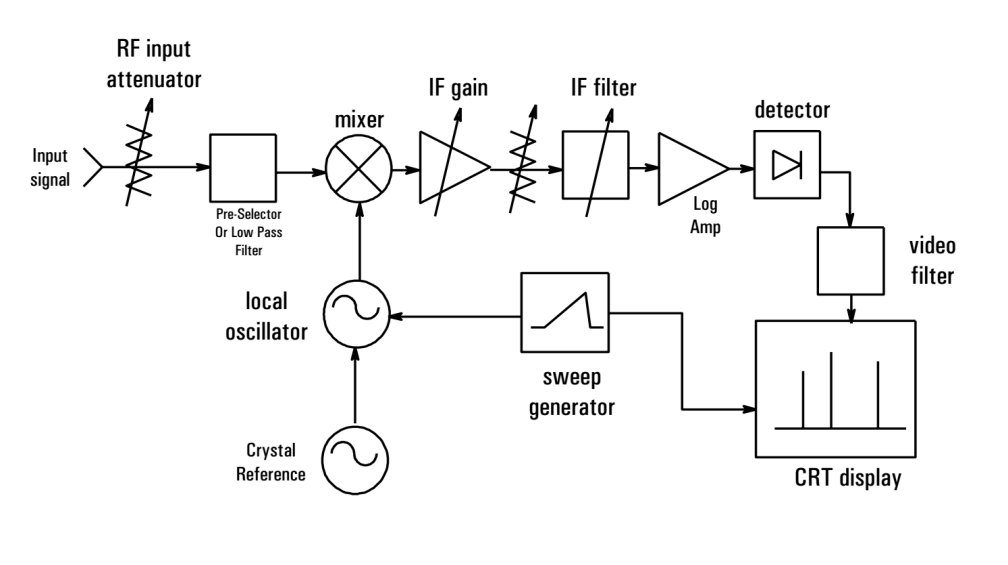
I know this is very scary. But these are the building blocks you should know when going for a professional level spectrum analyzer. In the following, I will try to walk you through some of the key things and features of any spectrum analyzer.
Technical parameters to look for in a spectrum analyzer
There are a lot of parameters that one should look for before getting any analyzer. The first would be the price range that is acceptable to your situation, the second would be the environment in which you are going to use it i.e. a USB or Benchtop.
The following are the technical parameters that decide the price of the best spectrum analyzer as well as its quality.
a. Frequency Range
By frequency range, I mean the range of signal frequencies that can be analyzed and swept by spectrum analyzers. When it comes to analyzing a signal, it is a good practice to see at least the fifth harmonic within that signal.
A rule of thumb is, that for the good measurement of the spectrum, the test signal must be within the operating frequency range of the spectrum. i.e. if you are measuring wifi or Bluetooth which are in the range of 2.4GHz you need a spectrum analyzer that has a frequency range of at least twice the mentioned frequency. But for higher frequencies, you have to pay a higher price.
b. Pre-amplifier
Pre-amplification is used to boost the very weak incoming signals. Adding a small signal amplification module to the spectrum improves the sensitivity of the system (preamplifier and spectrum analyzer). Mainly used to measure small signals.
c. Input Impedance
The terminal impedance is presented by the analyzer to the signal source. The rated impedance of RF and microwave analyzers is typically 50 Ω. For some systems (such as cable TV), the standard impedance is 75 Ω. Impedance mismatch will cause large measurement errors and even interfere with circuit operation.
d. Span
The shorter the span greater the sweep time, and thus you will have a better spectrum analyzer. As the name suggests, span is the frequency range you see on the x-axis of your spectrum analyzer. Now if you are measuring a small range of frequencies there is no need to go for your spectrum analyzer full sweep. As you are just wasting your time and compromising the accuracy of results. Instead, choose a close span according to your frequency and run it. This way you will better sweep time and better results.
For example, if you want to measure frequencies of range 9 – 20Mhz. Choose a span of 11Mhz with a start frequency of 9MHz and an end frequency of 20MHz.
e. Resolution Bandwidth (RBW)
The RBW plays an important role in resolving signals that are close together in the frequency domain. It is like the bandwidth of the band-pass filter dictates the resolution bandwidth, which is related to the minimum bandwidth detectable by the instrument.
Because of RBW, we can visually separate between two frequency components that are close to each other. The lower the RBW the better, and the higher the price of the analyzer.
f. Video Bandwidth
You know, when working with any electronic device noise is something you cannot ignore. The nose can be produced by internal components due to heat or the noise can be external. Either the case noise is something we want to eliminate as much as possible.
Video Bandwidth just helps us do so i.e. to eliminate the noise coming in the signals. The main focus of video bandwidth is to reduce the signal noise so that we can have a sharp and clean signal on the spectrum analyzer screen.
g. Input Power
The input power of the spectrum is divided into average continuous, pulse input power. The average continuous power is the maximum power value at which the instrument can continuously input signals. Pulse input power refers to the value of the pulse input power measured by the spectrum (strictly comply with the manufacturer’s required pulse width, duty cycle parameters).
The general unit of input power is expressed in dBm, and dBm is a value of the absolute value of the measured power. The calculation formula is: 10lg (power value/ 1mw). For example: 0dBm = 1mW, 20dBm = 100mW, 30dBm = 1000mW =1W.
h. Average Noise Level (DANL)
The average noise level is equivalent to the noise of the spectrum itself, and the choice is related to the minimum signal amplitude measured by the engineer.
The ideal state DANL is as small as possible, but as the DANL is smaller, the higher the technical complexity, the more expensive the price. The measurement is like seeing the reef when seawater is lower than the reef when sailing.
i. Tracking Source
A sweep signal source is added to the frequency spectrum to synchronize with the frequency spectrum. After adding a tracking source, scalar network parameters can be measured.
For example, the frequency characteristic curve of the unit under test (such as amplification circuit and filter circuit) can be tested, and the reflection coefficient, return loss, and standing wave can also be measured with the standing-wave ratio test suite.
Keeping the above information in my mind I have created the following list of some amazing best spectrum analyzers for beginners to professionals. I hope it will help you.
The list of best spectrum analyzers
I think I have shared all the information that I have about the topic. Now let have look at some spectrum analyzers. I will start with a very basic one then I will talk about some professional spectrum analyzers. So please keep on reading.
Also, keep in mind, I am not going to repeatedly talk about the above features of the spectrum analyzer over again and again. They are applied to all the below-mentioned models. Also, I am not going to add some fancy-looking models that you will see a bunch of them online. Look man, I am an engineer and technical terms are more romantic to me than the looks.
There are a lot of manufactures out there making quality spectrum analyzers. I am not talking about the very professionals here, I am focusing on beginners level analyzers. With so many manufactures, it’s hard to just say that one bitch is killing it.
The best spectrum analyzer for beginners that field professionals recommend is either the Ragol DSA815-TG, or the Siglent SSA3021X, or the Oscium Wipry 2500x. These are the best, cause they come from brands that have proven records in the industry, are of high quality, reliable, tested, and have frequency ranges that suit most of the practical scenarios.
In the rest of the article, I try to talk about the mentioned models.
1. Portable TinySA Spectrum Analyzer
Starting our list with a very basic analyzer i.e. TinySA. As the name is telling the whole story it is a spectrum analyzer suited to a tiny spectrum of frequencies.
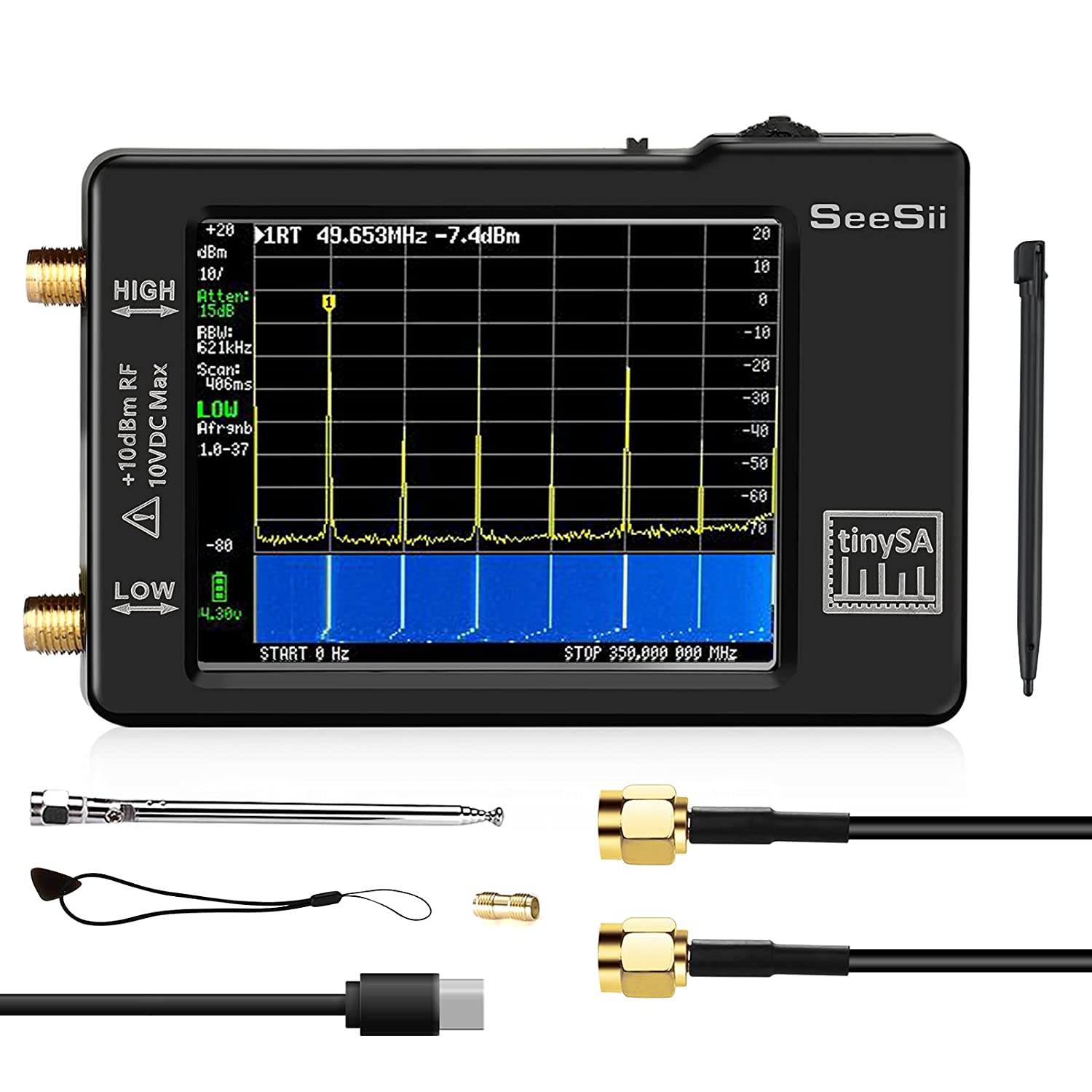
Some of the key features of this amazing small size spectrum analyzer:
- It is portable
- Can be used with a PC
- It is a touch screen
- It comes with two inputs, high-quality MF/HF/VHF input for 0.1MHZ-350MHz, lesser quality UHF input for 240MHz-960MHz.
- Switchable resolution bandpass filters for both ranges between 2.6kHz and 640kHz
- Color display showing 290 scan points covering up to the full low or high-frequency range.
- Input Step attenuator from 0dB to 31dB for the MF/HF/VHF input.
- When not used as Spectrum Analyzer it can be used as Signal Generator, MF/HF/VHF sinus output between 0.1MHZ-350MHz, UHF square wave output between 240MHz-960MHz.
To know more about this analyzer, here is the link for your own further investigation TinySA (Amazon link).
2. OSCIUM WiPry Spectrum Analyzer
Another starter best spectrum analyzer is WiPry. As the name is telling you it is designed for the range of Wifi signals i.e 2.4GHz. You can use this analyzer to analyze the signals from the baby monitor, Zigbee, and Bluetooth connection. If you are running all of these devices and interferences may be happening, this tool can help troubleshoot.
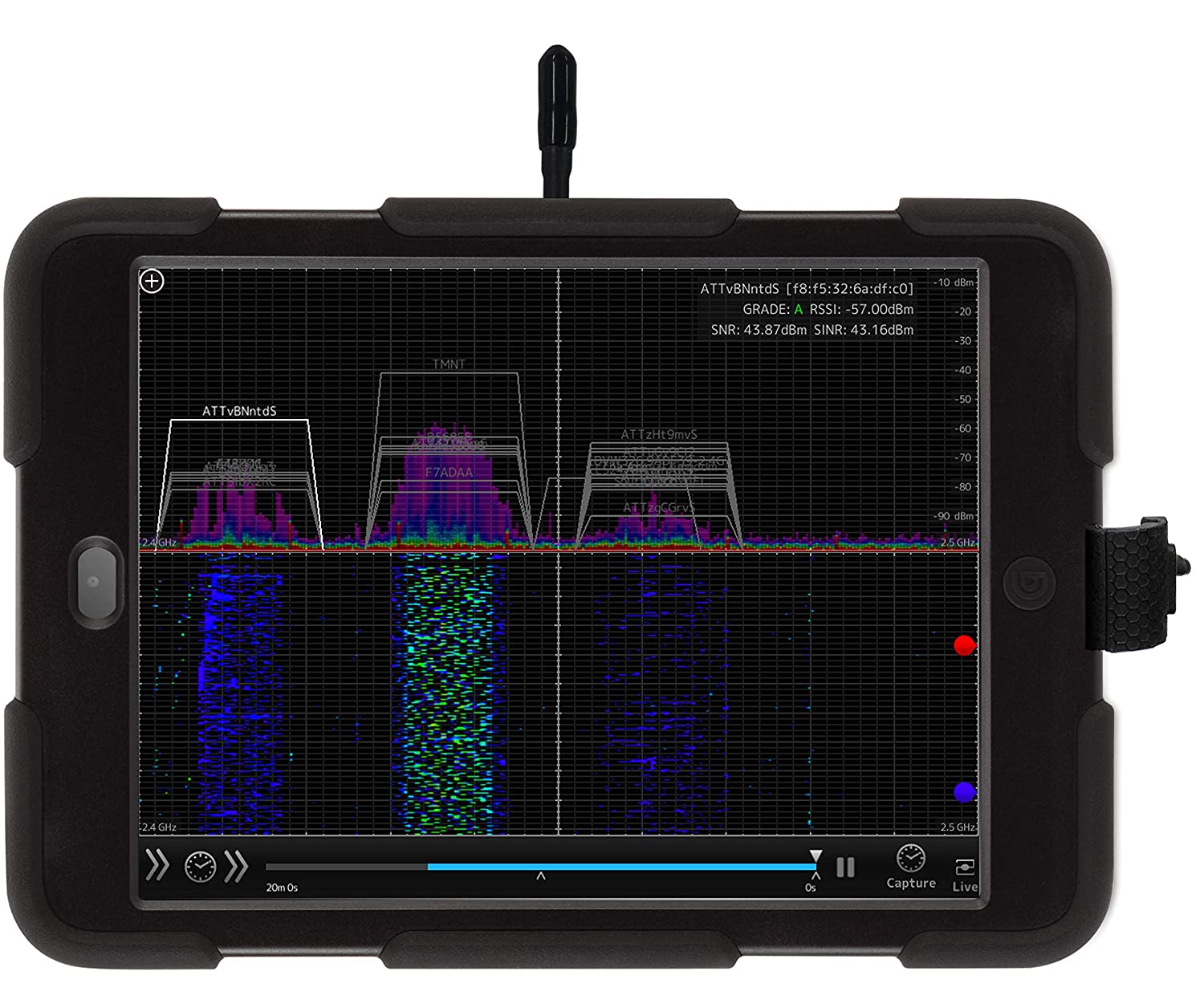
Important features:
- Frequency Range: 2.4 to 2.495 GHz & 5.15 to 5.85 GHz
- Frequency Resolution: 2.4 GHz: 333 KHz 5 GHz: 1.665 MHz
- Amplitude Range: -95 to 0 dBm; Amplitude Resolution: 0.5 dBm
- Antenna Port: RP-SMA Connector
To know more about this cool device, here is the link for your own research and investigation, WiPry (Amazon link).
3. Best spectrum analyzer from Tektronix RSA306B
Tektronix is a world-known brand. It is in the business for decades and going nowhere any soon. A lot of field professionals have used their products and are very happy with Tektronix.
There are a lot of models made by the mentioned brand, but the one I wanna list here is RSA306B. It is a real-time spectrum analyzer and you can carry it anywhere with you, or even you can use it in your lab as well.
Important features of RSA306B:
- 9 kHz to 6.2 GHz
- 40 MHz Acquisition Bandwidth
- Portable – USB spectrum analyzer ready to connect to a PC with USB 3. 0
- Improved Dynamic Range (reduced spurious)
- SignalVu-PC vector analysis software
- Customizable
- Affordable
In summary, the Tektronix RSA306B (Amazon link) is a powerful tool for you ever if you are seriously into the RF field. It is costly but worth the investment. It is portable, easy to use, and has a frequency range far way higher than you need.
4. Best spectrum analyzer from Ragol DSA815-TG
Rigol is a popular brand for making quality measuring instruments for decades. If you are into electronics for a long enough time, maybe you have already used some of its stuff.
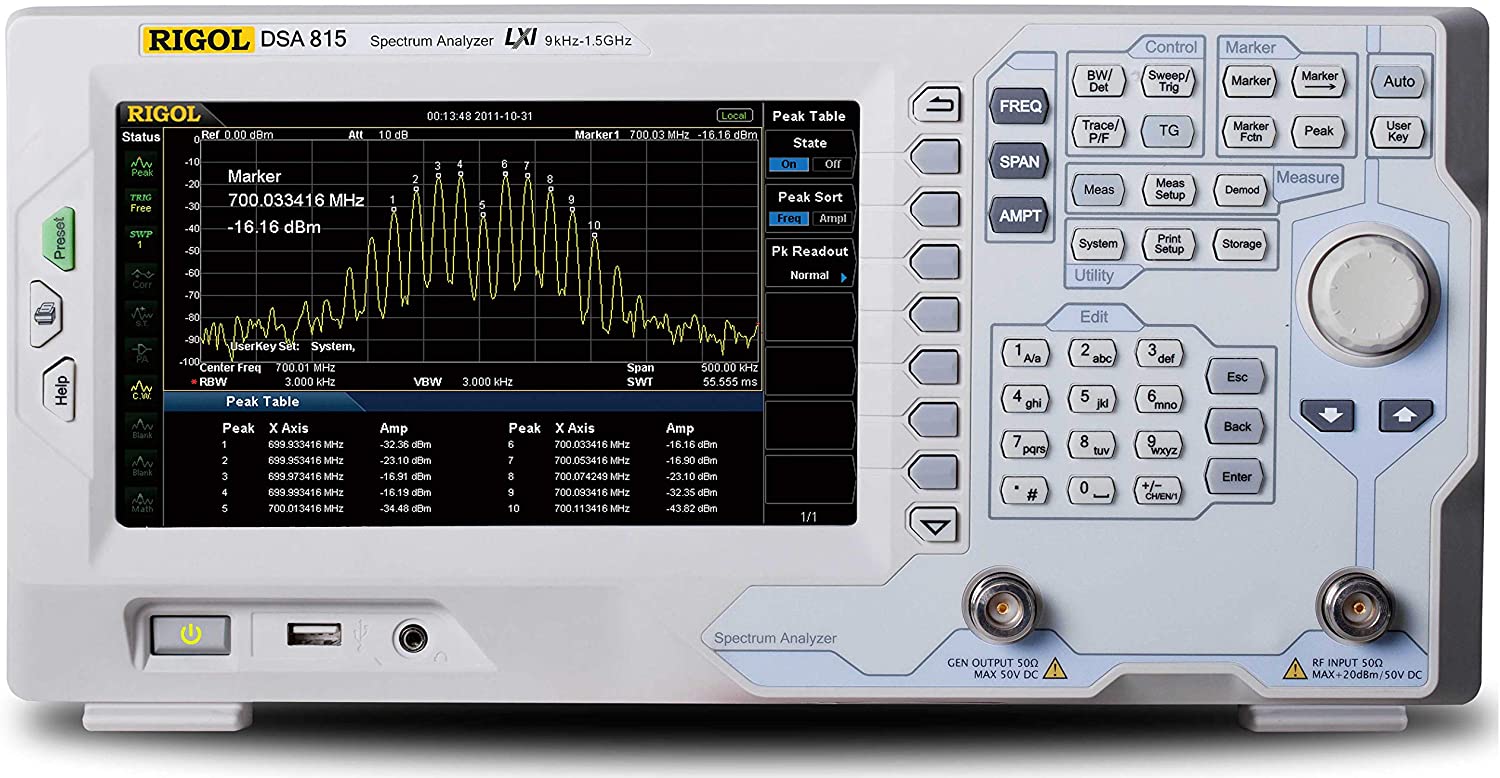
Important features:
- 9 kHz to 1.5 GHz frequency range
- Typical -135 dBm displayed average noise level (DANL)
- Total amplitude uncertainty < 1.5 dB
- 100 Hz minimum resolution bandwidth (RBW)
- Preamplifier and AM/FM demodulation function
- 8-inch high-definition (800×480 pixels) LCD
- Compact size, lightweight
- 1.5 GHz tracking generator
In summary, the Ragol DSA815-TG (Amazon link) is the best spectrum analyzer for its quality and price range. But keep in mind there are certain features that you have to buy to use i.e. the extended resolution bandwidth or the SWR capability.
5. Best spectrum analyzer from Siglent SSA3021A
Siglent is another popular brand for making quality electronic measurement instruments. A large portion of people are happy and recommend products from this guy in the business, based on their quality for such affordable price ranges.
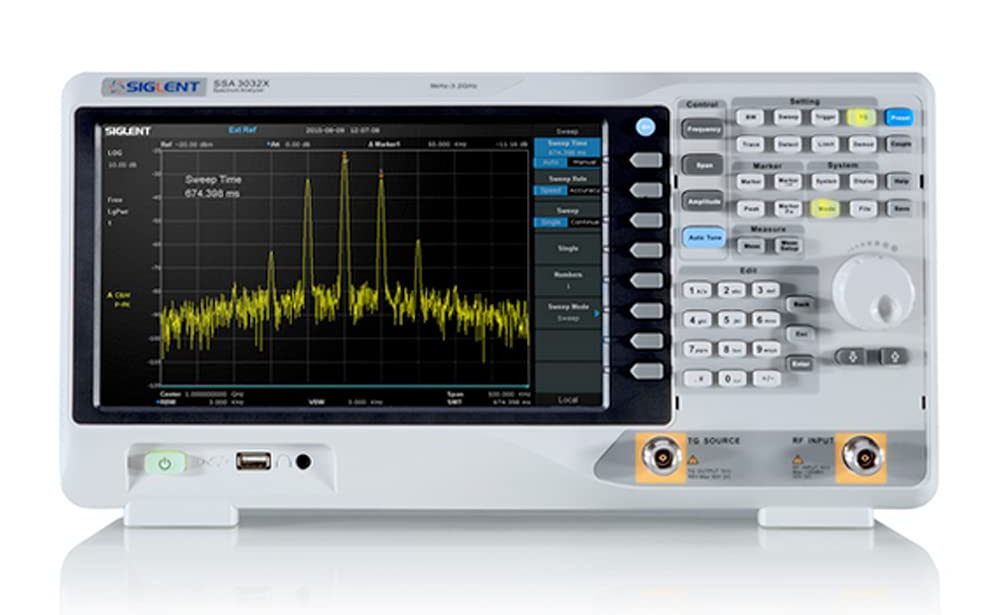
Important features of this best spectrum analyzer
- All-Digital IF Technology
- Frequency Range from 9 kHz up to 2.1 GHz
- -161 dBm/Hz Displayed Average Noise Level (Typ.)
- -98 dBc/Hz @10 kHz Offset Phase Noise (1 GHz, Typ.)
- Total Amplitude Accuracy < 0.7 dB
- 10 Hz Minimum Resolution Bandwidth (RBW)
- Standard Preamplifier
- 10.1-inch WVGA (1024×600) Display
- Up to 3.2 GHz Tracking Generator Kit (optional)
- EMI Pre-compliance Measurements Kit (optional)
In summary, the Siglent SSA3021X (Amazon link) is the power tool that comes with almost the same features as the above Rigol. Plus, its price is a little higher than the Rigol, but it has a high-frequency range as well.
6. Siglent Technologies SSA3032X Spectrum Analyzer
The difference between Siglent this model and the above one is the frequency range. The above one has a range of 9K to 2.1 GHz which doesn’t cover Bluetooth and wifi range. To tackle these measurements Siglent has this model i.e. SSA3032X.
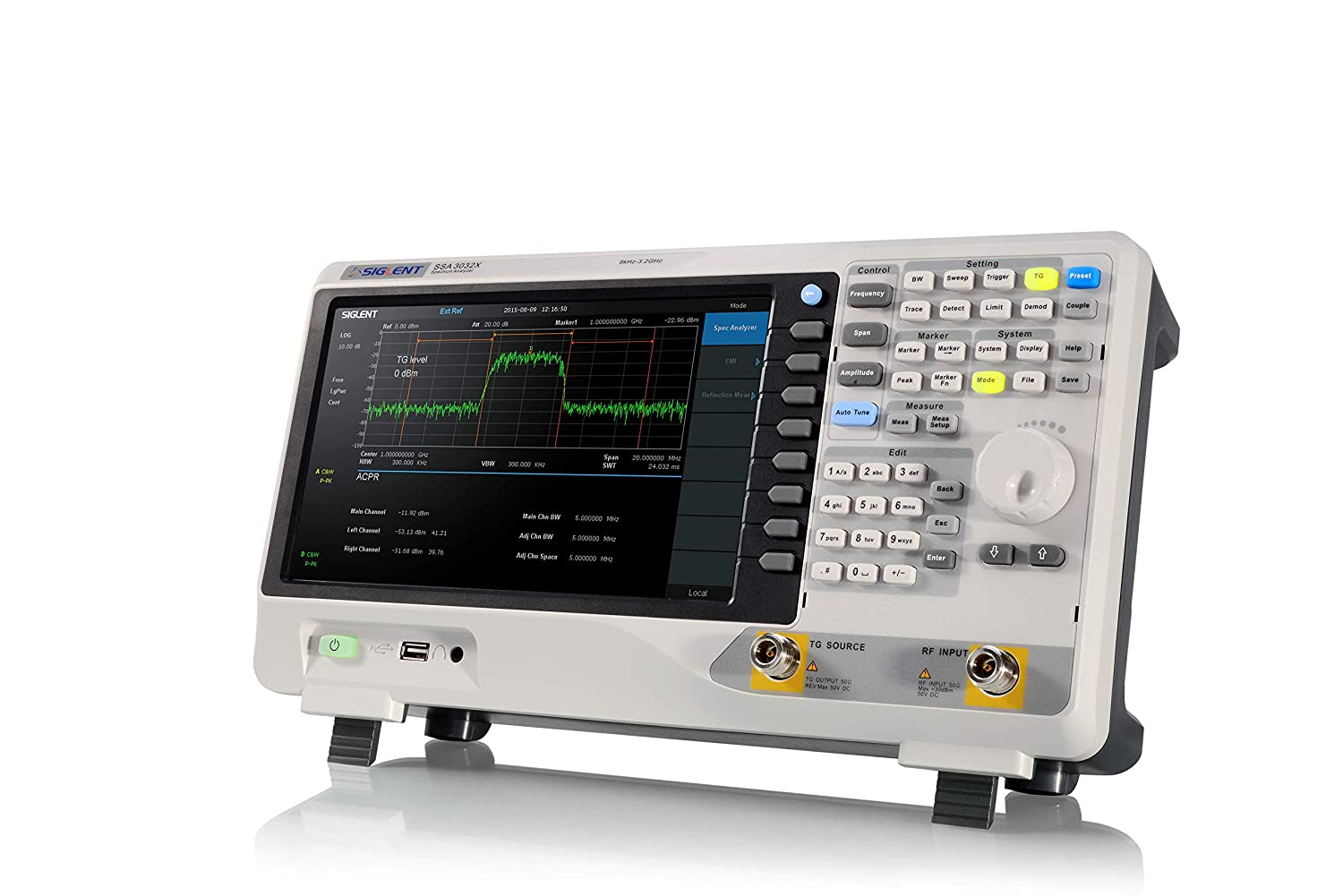
This model has identical features to that of the above. The great thing about this instrument is the resolution bandwidth that is able to reach 10 Hz. This allows you to accurately and carefully find two signal details that are closely separated. Even, you could display 4 traces with a different resolution bandwidth (RBW) at the same time on the screen.
To know more about the guy yourself, here is the link for your own investigations SSA3032X Spectrum Analyzer (Amazon link).
Conclusion
Buying the best spectrum analyzer is a tricky task. I suggest you do a lot of research before purchasing anyone, cause they are expensive tools. Besides your budget, the following are the factors one should keep in mind while judging the analyzers.
- Frequency range, the higher the frequency range the more expensive the analyzer
- Input impedance, make sure you are dealing with 75Ohm or 50Ohm standards
- Input power
- Resolution bandwidth
- Noise level
- Tracking generator
- Easy to use, like it should be that hard to handle
In this article, I try to list a few top spectrum analyzers that are quite acceptable for beginners and entry-level professionals. Everyone can use them.
Other posts:
- Best Oscilloscopes
- Best beginner multimeters: A complete buying guide
- Best Lab Power Supply [How to choose and buy the best]
Best cheap ESR meter – autorange, supports incircuit testing
Best EMF meter for beginners – Protect yourself from radiation
Buying electricians best voltage testers – what to think about
Thank you for making it this far. Enjoy your moments of life.

I am a musician, looking to calibrate a graphic Equalizer. This is for live music. Which device would you recommend ?